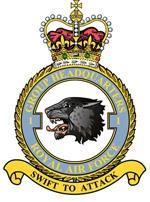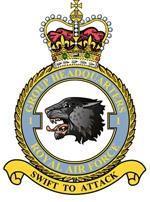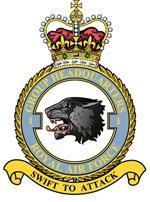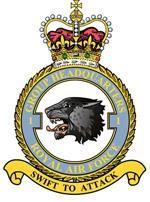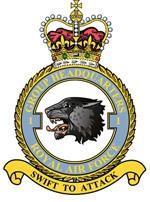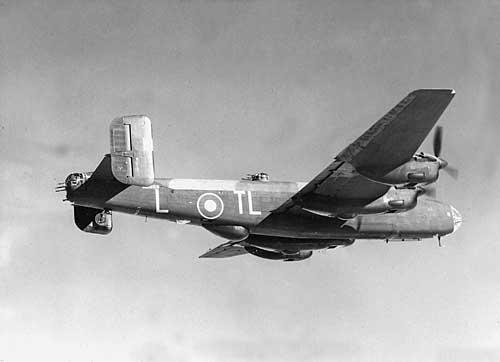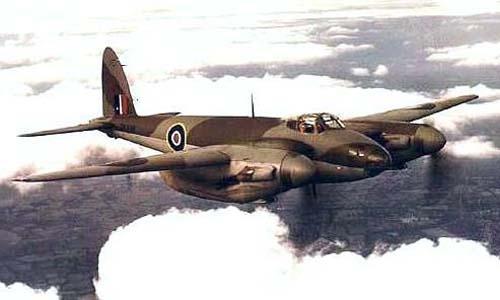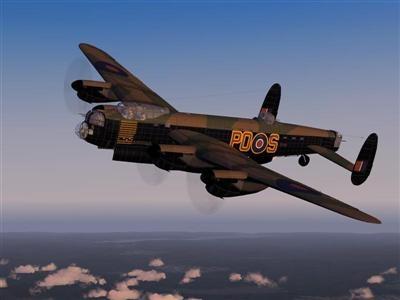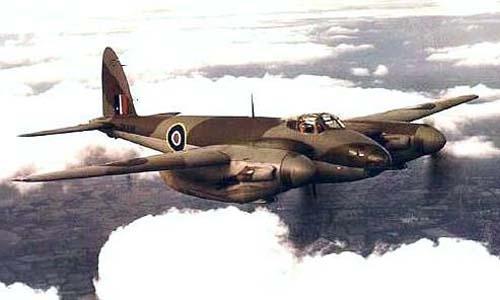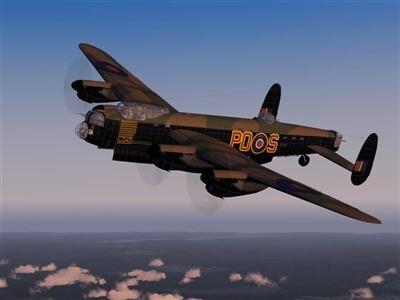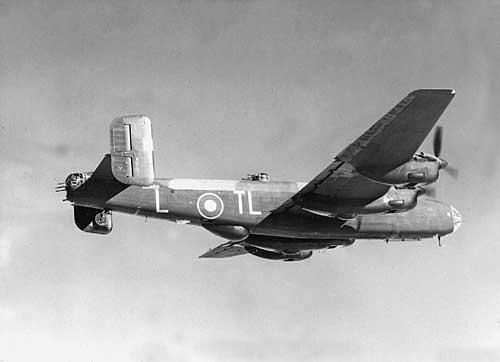
No. 1 Group
Motto: "Swift to attack."
Badge: A black panther's head erased. The badge commemorates the code-name Panther which the Group had in 1939 at the time of its mobilisation for service in France as the Advanced Air Striking Force.
Authority: King George VI, June 1941.
No. 1 (Bomber) Group came into being at Abingdon on 1st May 1936, when its nameplate was given to the Central Area of the Air Defence of Great Britain. The Group began life with three stations and ten squadrons: Abingdon, Nos. 15, 40, 98 and 104 Squadrons; Bircham Newton, Nos. 18, 21, 34 and 39 Squadrons; and Upper Heyford, Nos. 57 and 218 Squadrons. All its squadrons were equipped with Hawker Hind aircraft. By the end of 1938 the Group had expanded to eight stations and 17 squadrons equipped either with Bristol Blenheims or Fairey Battles.
On 24th August 1939, the Group was ordered to mobilise prior to proceeding to France as an advanced air striking force in accordance with a prearranged plan. By this time the Group had shrunk to ten squadrons, all equipped with Battle aircraft and located in pairs at Abingdon, Harwell, Benson, Boscombe Down and Bicester. On receipt of orders to move to France, Headquarters No. 1 Group became Headquarters Advanced Air Striking Force and the station headquarters and associated squadrons became Nos. 71, 72, 74, 75 and 76 Wings respectively.
Following the despatch of the AASF, plans, prepared in peacetime, were put into effect to form a new Headquarters No. 1 Group which, it was intended, should assume command of the Battle Wings on the arrival of the Second Echelon (formerly No. 2 Group) in France, Headquarters AASF assuming command of both echelons. Headquarters of the new No. 1 Group began to form at Benson on 12th September. On 29th September, however, the Air Ministry decided to postpone the despatch to France of the Second Echelon (of which No. 1 Group Headquarters formed part), less certain units, and eventually, on 22nd December 1939, Headquarters No. 1 Group were disbanded.
The AASF, after having put up a gallant fight against overwhelming odds, returned to England in June 1940, and No. 1 Group was then re-formed. The Battles with which it was once again equipped operated from Newton and northern airfields against Dutch and French ports, the Group Headquarters being at Hucknall, Notts. By the end of the year the Group was in the midst of converting to Wellingtons. King George VI and Queen Elizabeth visited two of the stations, Swinderby and Syerston, on 27th January 1941, and during that month Nos. 103, 300 and 301 (Polish) and 150 Squadrons carried 31 tons of bombs to enemy targets. By April 1941, eight squadrons were operational - Nos. 12 and 142 (Binbrook), 103 and 150 (Newton), 300 and 301 (Swinderby) and 304 and 305 (Syerston).
On the night of 16/17th October Pilot Officer AJ Heyworth, of No. 12 Squadron, flew a Wellington back from Mannheim on one engine for five hours. He covered between 500 and 600 miles in this way, and landed with the other engine on fire.
In August 1942 No. 103 Squadron was fully operational on Halifax heavy bombers. In September No. 101 Squadron joined the Group from No. 3 Group and went to Holme-on-Spalding Moor. October 1942, saw the first raid on Italy since September 1941, and by November Nos. 460 and 103 Squadrons were flying Lancasters. In December No. 100 Squadron, which had been annihilated during the Japanese invasion of Malaya and Java, was re-formed at Grimsby.
Air Vice-Marshal RD Oxland handed over command of the Group to Air Vice-Marshal EAB Rice on 24th February 1943, having been the Air Officer Commanding (AOC) for more than two years. The new AOC had only been in residence a few days when the Group reached the record of 1,000 tons of bombs in one month, a figure of 1,694 tons being achieved for February. The Skoda works at Pilsen were attacked in April.
The main force was "stood down" in May 1943, during the moon period, a policy that was to last for some time, but on one moonlight night No. 103 Squadron put up 27 Lancasters. In June, Holme and Breighton were handed over to No. 4 Group and No. 101 Squadron moved to Ludford Magna, where it remained based for the rest of the war. The Group switched from the Battle of the Ruhr to the Battle of Hamburg in July, and the monthly bomb total for August was approximately 5,000 tons. The targets included Milan, Turin, Genoa, Peenemunde, Nuremberg and Berlin. In the same month, No. 460, the Australian Squadron, flew 271 sorties and dropped 1,110 tons.
In the autumn of 1943 the first base station (No. 12 at Binbrook) was introduced with sub-stations at Grimsby and Kelstern. The Group pounded Berlin with four major attacks in nine days in November. North Killingholme opened in November, accommodating No. 550 Squadron, while No. 626 Squadron started operations from Wickenby. Two more bases were added to the strength in December, No. 13 (Elsham, Kirmington and North Killingholme), and No. 14 (Ludford, Wickenby and Faldingworth).
On 15th February 1944, 139 Lancasters dropped their bombs on Berlin in the heaviest attack ever made on the capital. In March No. 300 (Polish) Squadron completed its last mining operation with Wellingtons. Twenty-one aircraft failed to return from Nuremberg on the last night of the month. There was a welcome contrast on the final night of April. An enemy ammunition dump at Maintenon was two-thirds destroyed.
The Prime Minister of Australia, the Right Honourable John Curtin, visited Binbrook in May, where a presentation was made to him of Lancaster W4783 "G-George". This veteran aircraft was later flown to Australia and is now displayed at the Australian War Memorial at Canberra. It reached No. 460 Squadron on 22nd October 1942, and logged 90 operational sorties.
No. 1 Group had heavy commitments in May and June, smashing the V-sites, gun emplacements and railway centres, and weakening German resistance generally. This was not done without losses. On the night of 3rd May the military centre of Mailly-le-Camp was hit in bright moonlight. Bombers and fighters were mixed up in dogfights over the target and 28 aircraft of No. 1 Group failed to return. In June 1944, the Group broke all records by dropping 15,062 tons of bombs. This exceeded the total weight for the whole of 1941-42. The loss rate was the lowest for 16 months - 1.9 per cent. The attack on Le Havre was the first big daylight effort with fighter escort. A few hours before the invasion of France No. 101 Squadron played an historic part, undertaking prolonged patrols over France and around the coast, and all the time jamming the enemy's radar system. June saw 36 operations in 22 days.
No. 15 Base was formed at Scampton, its sub-stations being Hemswell and Fiskerton, but towards the end of the year No. 11 Base at Lindholme, with its sub-stations, became part of the newly-formed No. 7 (Training) Group. At the beginning of November Group Captain HI Edwards, VC, who had been Commanding Officer at Binbrook since February 18th 1943, handed over command to Group Captain KR Parsons. The Group was going from strength to strength and contributed 312 aircraft to the Command efforts on one night. In three months ending 15th December, 200 DFCs, 62 DFMs, 5 DSOs, 13 bars to DFCs and one CGM had been gained by Group aircrew.
One of the No. 1 Group Lancasters, ED888 "M2" or "Mike Squared", of No. 103 Squadron, was withdrawn from active service by January, having flown 140 sorties, including 98 to Germany, 15 of these being to Berlin. No other Lancaster in the whole of Bomber Command equalled this performance.
Air Vice-Marshal RS Blucke was appointed AOC in February, a month in which there were the full-scale and long-distance attacks on Dresden and Chemnitz. Flying Officer DH Roberts and Flight Sergeant CE Jones of No. 12 Squadron (Wickenby) shot down three fighters by splendid teamwork. As the war reached its climax, March sent the statistics soaring, with 3,764 sorties and 17,260 tons of bombs and 380 mines. No. 166 Squadron led the field with 1,771 tons, the tenth month in twelve in which it had exceeded 1,000 tons.
The Group ceased fire in April and it was fitting that on 25th April the last big attack should have been on Berchtesgaden. Another highlight was the sinking of the pocket battleship Scheer at Kiel. Then began the more peaceful sorties-dropping food supplies in Holland and the bringing back from Germany of liberated prisoners of war. Several thousand men were brought back to England in the Group's Lancasters.
The final statistics show that the Group flew a total of approximately 57,900 operational sorties during the war, dropping 238,356 tons of bombs and laying 8,147 sea mines. In these operations 8,577 aircrew lost their lives.
WWII Headquarters:
Benson : Sep 1939-Dec 1939
HQ disbanded 22.12.39. Group re-formed 22.6.40 with HQ at
- Hucknall : Jun 1940-Jul 1941
- Bawtry Hall, Bawtry : Jul 1941 onwards
WWII Air Officers Commanding:
- Air Vice-Marshal AC Wright : 3 Sep 1939
- Air Commodore JJ Breen : 27 Jun 1940
- Air Vice-Marshal RD Oxland : 27 Nov 1940
- Air Vice-Marshal EAB Rice : 24 Feb 1943
- Air Vice-Marshal RS Blucke : 12 Feb 1945
- Thunderclap Feb-March


